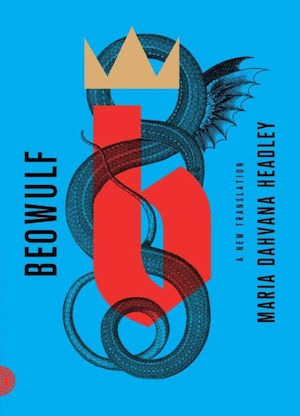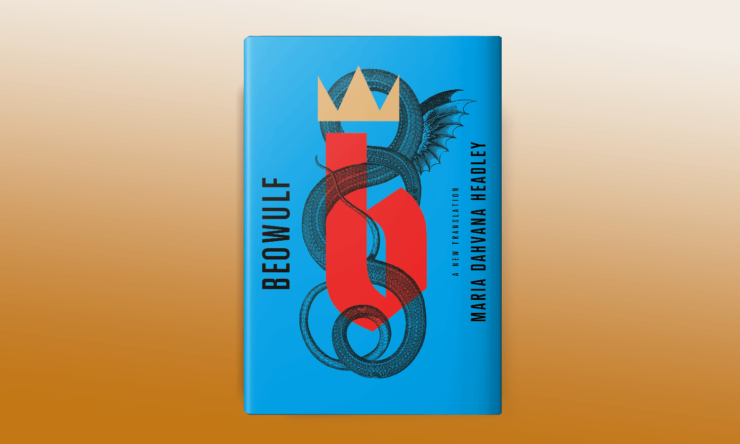It’s not very often that a thousand-year-old poem has a new translation that gets people hyped up, at least in the Anglophone world, but Maria Dahvana Headley’s recent Hugo Award-winning translation of Beowulf stirred up a lot of interest—there’s even a video series of writers and entertainers reading it out loud. (Alan Cumming’s section is excellent—he really knows his way around alliterative verse.)
Translation is a fascinating topic. I talked about some of my own experiences with translating dead languages in a previous column on Turning Darkness into Light and how Marie Brennan uses dead languages to great effect in that book. Today, I’m going to talk a little bit about theories of translation, then I’m going to get into the specifics of Headley’s new translation.
Translation is a surprisingly controversial field. One might think “oh, you just take these words and turn them into these other words, how’s that so hard?” But the reality of translation isn’t quite that simple or straightforward. The translator has to decide how they’re going to translate some things, such as cultural references. You’re probably familiar with the Pokémon anime series. There’s a scene where Brock is eating rice balls (onigiri), and the US dub calls them “jelly donuts.” This is widely seen as an absurd choice, because onigiri look nothing like donuts and don’t even really fill the same gustatory niche. However, the target demographic for the show is elementary school kids, regardless of what other demographics also watch it. The average (probably White) first grader isn’t going to pay that much attention, or even really care, the logic goes, so why not use something American instead? That in turn raises the question of whether this is cultural homogenization or some other type of racism, and now the whole translation question doesn’t look so simple, does it?
For an example of localization that works spectacularly for our purposes, take the Ace Attorney video games. They star a man named Phoenix Wright and his rival Miles Edgeworth, and the witnesses in their cases have names like Larry Butz. Edgeworth has a paralyzing fear of earthquakes. They’re given a vaguely Californian setting in the US version. The original Japanese names of the rival attorneys are Naruhodo Ryuichi and Mitsurugi Reiji, and the game is FULL of puns and word-play. When Capcom brought the game to the English market, they had to make these puns make sense, or the players wouldn’t enjoy the games. Naruhodo means “I understand” or “I get it,” so the localization team went with Wright (right?), and the characters used to write Mitsurugi include “sword,” so: Edge-worth.
So, when something is translated into another language, the translator has to make a lot of decisions about what overall strategy they’re going to use, and sometimes those decisions don’t please everybody. Sometimes those decisions don’t please anybody: This Twitter thread offers a good summary of controversies in anime subtitling.
Beowulf, as you may remember from high school, is the oldest English-language epic poem that we know of and tells the story of the hero Beowulf, who comes to Heorot Hall to save the people there from the Grendel, a monster who attacks people while they sleep. Then Grendel’s mother attacks and Beowulf kills her, too. The original text is in Old English in the heroic epic style, which in the Germanic languages means alliterative verse.
There are a lot of specific types of alliteration used in Germanic verse, which I won’t go into, but there’s a nice Wikipedia article on it if you’re interested. But here are the highlights: The first stressed syllable will alliterate with another stressed syllable in the same half-line and with one or two in the subsequent half-line. There can be more alliteration in a line than this, and it may also go across lines, but there will always be at least one alliterated syllable on each half-line. Modern English speakers still find alliteration pleasing and poetic, and we still use it, but not in the same way as Germanic alliterative verse. [Side note: all of Tolkien’s songs of the Rohirrim are in alliterative verse. Dude knew what he was about.]
Buy the Book


Beowulf: A New Translation
This is relevant to the question at hand, because when a modern English speaker decides to translate Old English poetry, they have to decide what to do about the underlying alliterative structure. They also have to decide whether to try to retain the original meter or not, and whether to use verse or prose . Because Old English had extensive case markings on nouns and adjectives, it didn’t rely as much on word order as modern English does to convey information, which means the poets could swap things around to make the alliteration or meter work in ways which would sound wrong today.
So, what Headley decided to do with her translation was to make it modern by using modern slang, mostly bro-speak, to recontextualize it for the modern reader. Probably the most talked-about translation choice she made was to use “Bro!” for the Old English “Hwæt.” The word, pronounced pretty much like it looks—rhymes with “at”—means “what,” but in this context, i.e. the opening of an epic poem, it serves the function of getting the listener’s attention: “Listen! I’m about to sing a song.” So when Headley opted for “Bro!” here, she drew on a modern reader’s knowledge of the various ways people start telling stories. She could have gone with “Hey!” or “So” (Seamus Heaney’s choice) or “Yo” or even “Listen up!” and each of these choices would reflect a particular style. (Imagine “So, back in the old days, we spear-Danes used to know the stories of princes and kings.”) One of the things I appreciated about Headley’s translation was that she kept alliteration and kennings when it was possible, even as she threw in modernisms like “hashtag blessed.” A kenning is a short phrase that is a metaphor for something else, like “the whale-road” for the sea. Poets could use these to make the alliteration or meter work, and they sound pretty cool. You could even say that phrases like trash panda (raccoon) or danger noodle (snake) are modern kennings.
Headley says in her introduction that she is as interested in the archaic as in the modern, so she wanted to preserve the original feel. This means sometimes she invented new kennings, and sometimes used the original ones. Sometimes it didn’t work for me, whether because it felt forced or just that the whiplike snap of anachronism was too much. Here are some examples of things that didn’t work for me.
(19-20) We all know a boy can’t daddy until his daddy’s dead.
I don’t have “daddy” as a verb in my mental lexicon, and all I can think about is how tumblr uses daddy, and I’m pretty sure that’s not what’s intended here.
(236 ff) How dare you come to Denmark costumed for war? Chain mail and swords?! There’s a dress code! You’re denied.
Here, the border guard is accosting Beowulf and company, and he’s treated like a bouncer at a club. It feels forced to me.
(802-803) His spells warded him, annealing his skin.
Anachronism whiplash on this one.
On the other hand, here are some that I thought were excellent:
(101-102) Grendel was the name of this woe-walker, unlucky, fucked by fate.
Woe-walker is a great use of kennings (which, as noted, allow the poet to provide alliteration where otherwise would be difficult), and, yes, “fucked” is one of those Modern Words but really it isn’t, so the vulgarity here works.
(29-30) back when mind and meter could merge in his mouth
This is a really cool image AND a good example of alliteration.
(845 ff) He’d left a river of gore, and the warriors had no regrets, imagining him dropping, a doomed carcass, into those wicked waters, which even now were blood-clotted, scarlet drifts. O, the gift of this! That devil-diver, deep in the dark, dimmer, and dimmer yet, dying, dying, dead!
This. I just. Wow. This is a beautiful mix of archaic and modern, and it’s just so well done. In the reading linked above, it’s in Alan Cumming’s section, and you all need to hear him read this.
So! Have you read this translation? What did you think? What’s your favorite bit? How does it compare with other versions of Beowulf you may have read, and what are your thoughts on the differences?
CD Covington has masters degrees in German and Linguistics, likes science fiction and roller derby, and misses having a cat. She is a graduate of Viable Paradise 17 and has published short stories in anthologies, most recently the story “Debridement” in Survivor, edited by Mary Anne Mohanraj and J.J. Pionke. You can find her current project, a book on practical linguistics for writers, on Patreon.










